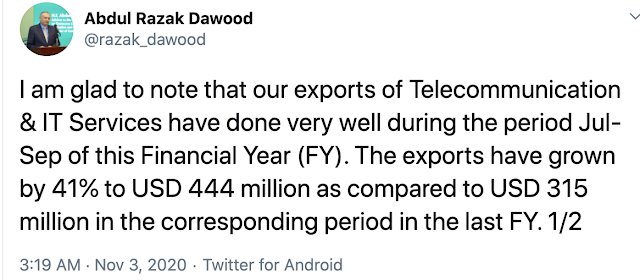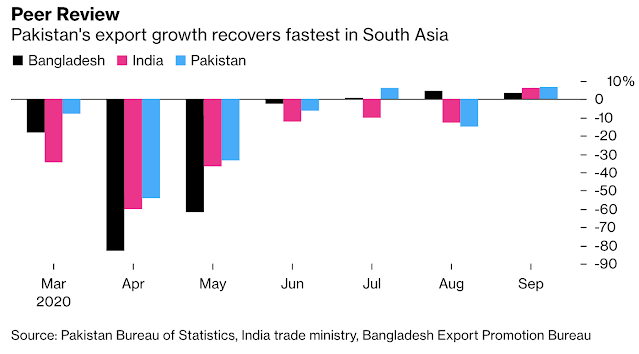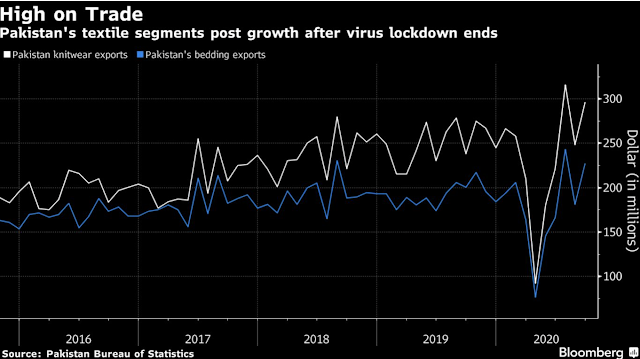PakAlumni Worldwide: The Global Social Network
The Global Social Network
Soaring Exports of Pakistan's Information Technology and Pharma Industries Amid COVID Pandemic
Pakistan’s IT exports increased by 44% during the first quarter (July, August and September) of the fiscal year 2020-21, according to a tweet by Razzak Dawood, Special Assistant to Prime Minister Imran Khan. Pharmaceutical exports saw 22.6% increase in the same period over last year. Pakistan's information technology and pharmaceutical exports are soaring by double digits amid the COVID pandemic, much faster than the overall exports.
 |
| Razzak Dawood on IT Exports |
In Fiscal Year 2019-20 ending in June, 2020, the Information Telecommunication (IT) and IT enabled Services (ITeS) export remittances surged 23.71% to $1.230 billion from $994.848 million during the same period in the prior year, according to Pakistan Bureau of Statistics as reported by Pakistani media.
With several major brands moving production to Pakistan amid the COVID19 pandemic, the country's exports have grown at a faster pace than those of Bangladesh and India, according to Bloomberg News. Pakistan's total textile shipments rose 7% in September, compared with India’s 6% and Bangladesh’s 3.5%.
 |
| South Asia Region's Exports. Source: Bloomberg |
“Pakistan has seen orders shifting from multiple nations including China, India and Bangladesh,” said Shahid Sattar, secretary general at the All Pakistan Textile Mills Association, in an interview with Bloomberg's Faseeh Mangi. “Garment manufacturers are operating near maximum capacity and many can’t take any orders for the next six months.”
 |
| Pakistan's Textiles Growth. Source: Bloomberg |
Bloomberg attributed Pakistan's export surge to Prime Minister Imran Khan’s administration to be the first in South Asia to ease the COVID19 lockdown after controlling the spread of the disease. It helped draw companies like Guess Inc., Hugo Boss AG, Target Corp. and Hanesbrands Inc.
 |
| IPO Spree in Karachi Stock Market. Source: Bloomberg |
 |
| Covid19 Cases in Pakistan. Source: Our World in Data |
 |
| Pakistan Monthly Quantum Index of Manufacturing. Source: PBS |
Cement Sales:
Pakistan is once again experiencing a construction boom with new incentives under Naya Pakistan Housing Program. Monthly cement sales rose to near all-time high of almost 5 million tons in July 2020 as construction activity picked up in both housing and CPEC-related projects.
 |
| Pakistan Cement Sales. Source: Bloomberg |
Car Sales:
Gasoline sales in June, 2020 hit new record and local car deliveries rose to about 10,000 units as people returned to work after easing of lockdown in May, 2020. Kia Motors Corp.’s local unit is planning to add a second shift at its factory in Karachi from January.
 |
| Pakistan Car Sales Recovery. Source: Bloomberg |
Multiple Sectors Growing:
Sectors including food, beverages & tobacco, coke & petroleum products, pharmaceuticals and non metallic mineral products saw an increase in production in July 2020. Muzzammil Aslam, chief executive officer at Tangent Capital Advisors Pvt., was quoted by Bloomberg as saying, “It has surprised everybody". Aslam expects Pakistan economy at 4%-5% in current fiscal year, higher than the government’s 2.1% target. “The growth is led by an aggregate demand push.”
Summary:
Pakistanis have defied all foreign and domestic doomsayers, including media, activists and think tanks of all varieties. Pakistan has successfully fought off the deadly COVID19 virus and begun to bounce back economically. Pakistan’s IT exports increased by 44% during the first quarter (July, August and September) of the fiscal year 2020-21, according to a tweet by Razzak Dawood, Special Assistant to Prime Minister Imran Khan. Pharmaceutical exports saw 22.6% increase in the same period over last year. With several major brands moving production to Pakistan, the country's exports are rebounding faster than its peers in South Asia. Moody's rating agency has raised Pakistan's economic outlook from "under review for downgrade" to "stable". Pakistan's Planning Minister Asad Umar is talking of a "V-shaped recovery". Monthly cement sales have rebounded to pre-pandemic level, fuel sales have increased, tax collection is up, exports are rising and the Karachi stock market is booming again. Prime Minister Imran Khan and Army Chief General Javed Bajwa have been on the same page in tackling the health and economic crises faced by Pakistan. Contrary to the critics of Pakistan's civil-military ties, Khan-Bajwa cooperation has been one of the keys to the country's success in dealing with the twin crises.
Related Links:
Haq's Musings
South Asia Investor Review
Pakistan Pharma Industry
COVID19 in Pakistan: Test Positivity Rate and Deaths Declining
Construction Industry in Pakistan
Pakistan's Pharma Industry Among World's Fastest Growing
Pakistan to Become World's 6th Largest Cement Producer by 2030
Is Pakistan's Response to COVID19 Flawed?
Pakistan's Computer Services Exports Jump 26% Amid COVID19 Lockdown
Coronavirus, Lives and Livelihoods in Pakistan
Vast Majority of Pakistanis Support Imran Khan's Handling of Covid1...
Pakistani-American Woman Featured in Netflix Documentary "Pandemic"
Coronavirus Antibodies Testing in Pakistan
Can Pakistan Effectively Respond to Coronavirus Outbreak?
How Grim is Pakistan's Social Sector Progress?
Pakistan Fares Marginally Better Than India On Disease Burdens
Trump Picks Muslim-American to Lead Vaccine Effort
Democracy vs Dictatorship in Pakistan
Pakistan Child Health Indicators
Pakistan's Balance of Payments Crisis
Panama Leaks in Pakistan
Conspiracy Theories About Pakistan Elections"
PTI Triumphs Over Corrupt Dynastic Political Parties
Strikingly Similar Narratives of Donald Trump and Nawaz Sharif
Nawaz Sharif's Report Card
Riaz Haq's Youtube Channel
-
Comment by Riaz Haq on December 19, 2020 at 10:10am
-
Inadequate export industry base
https://www.pakistantoday.com.pk/2020/12/19/inadequate-export-indus...
Although the country’s exports have picked up in the past few months, Pakistan still has a long way to go if it is to compete with regional players such as Bangladesh and India. Last month, on the back of double-digit proceeds, a 32-month high of $2.16 billion was recorded in November, driven predominantly by textile exports, followed by pharmaceutical products, rice and surgical goods. Adviser to the Prime Minister on Institutional Reforms and Austerity Ishrat Husain, speaking at a recent event, correctly stated that Pakistan’s exports cannot grow beyond the annual $25 to $30 billion unless there is diversification and a move towards new industries is made. One of the fundamental reasons why Pakistan has been unable to achieve this is the disproportionately high level of incentives and support in the form of tax rebates provided by the government to a handful of sectors that make up to 90 percent of total exports. Unless there is a concentrated effort by the government to attract investment into other industries, the situation will remain the same and exports stagnant. It would be unrealistic to expect investors to set up a business that is unlikely to get support from the government while an industry already exists that receives ample subsidies and protections, enabling it to thrive.
Another issue is the overreliance on the US and EU markets, that are not growing rapidly enough to justify sticking to them only. In comparison, China and other Asian markets are growing at 5 to 6 percent. China is not only the largest exporter but also the largest trading nation in the world. Pakistan should leverage its strong alliance with the country and tap into its supply chains, providing raw materials and components, boosting its own exports. Another significant impediment to diversifying the export sector is the existence of powerful lobbies that are able to secure and preserve a competitive advantage through the government and other relevant power centres, making it near impossible for new entrants to survive, much less grow. Unless these systemic issues are addressed, Pakistan’s exports will struggle to reach the volume required for it to be considered a serious regional player.
-
Comment by Riaz Haq on December 19, 2020 at 8:24pm
-
#Pakistan #Textile #exports rise 4.88% year-on-year to $6.04 billion between July to November FY21 compared to $5.76 billion in the same period last year. In November, export proceeds were up by 9.27% from a year ago. #economy #Covid_19 https://www.dawn.com/news/1596602
In November, export proceeds were up by 9.27pc from a year ago. In October, export proceeds were up by 6.18pc and in September, they grew by 11.03pc while a decline of 15pc was recorded in August.
In the first month of the current fiscal year, exports recorded a robust increase of 14.4pc on a year-on-year basis. The rebound in exports of textile and clothing is the outcome of a series of incentives to support exporters to meet the challenges in the wake of the pandemic and disruption in supplies.
The demand for country’s exports had collapsed in months following March due to the Covid-19 pandemic, while there has been a gradual improvement since June from international buyers.
Adviser to PM on Commerce in a tweet said that in November, the exports of cotton yarn declined by 25pc, raw leather by 21pc, and cotton fabric by 12.2pc. “This is an indication that exports of low value-added products are decreasing and we are moving towards more value-added exports”, he said while adding that “I urge our exporters to keep pursuing this policy.”
The PBS data showed that ready-made garment exports edged up by 4.36pc in value while plunging in quantity by 44.64pc during July to November this year from a year ago. Exports of knitwear increased by 14.34pc in value and 32.35pc in quantity; bedwear exports were up 12.28pc while dipped 7.95pc in quantity.
Towel exports went up 14.24pc in value and 3.79pc in quantity, whereas those of cotton cloth dipped 8.73pc and 31.78pc in quantity.
Among primary commodities, cotton yarn exports plunged by 37.34pc, yarn other than cotton by 16.69pc, made-up articles — excluding towels — was up 15.53pc and tents, canvas and tarpaulin increased by a massive 58.05pc during the months under review.
Textile machinery imports dropped by 6.07pc during the first five months of current fiscal year — a sign that no expansion or modernisation projects were taken up by the industry in the given period.
Petroleum imports declined 22.78pc in the first five months (July-November) to $3.94bn, compared to $5.11bn over the last year, the PBS data showed.
Of these, petroleum product imports were down 16.51pc in value in the first five months’ despite increasing by 54.42pc in quantity. Similarly, import of crude oil dipped 27.01pc in value, but posted a growth of 14.78pc in quantity during the period under review while those of liquefied natural gas fell by 34.73pc in value. On the other hand, liquefied petroleum gas (LPG) imports jumped 52.06pc in value in July-Nov, largely to plug a shortfall in local production.
Machinery imports went down 5.78pc to $3.37bn in the first five months from $3.58bn last year. The decline in imports was recorded in almost all kinds of machinery except power generating machinery, office machinery and mobile phones.
The power generating machinery imports went up 21.73pc in the first five months mainly due to revival of power projects under the China-Pakistan Economic Corridor and office machinery increased by 0.7pc during the months under review.
In the telecommunication sector, imports surged by 31.32pc on the back of mobile handsets arrivals which were up by 45.26pc. This was the result of a crackdown on smuggling and doing away with free imports in baggage schemes. Import of other apparatus fell by 6.39pc.
The overall transport group witnessed a growth of 13.92pc. This growth was mainly driven by an increase in imports of road motor vehicles (build unit, CKD/SKD) and CBU during the months under review.
An increase of 60.36pc was seen in imports of textile group — raw cotton, synthetic and artificial silk yarn.
-
Comment by Riaz Haq on December 22, 2020 at 9:15am
-
PM Imran lauds ‘remarkable turnaround’ in Pakistan’s economy
https://tribune.com.pk/story/2276921/pm-imran-lauds-remarkable-turn...
Prime Minister Imran Khan on Tuesday said the country's foreign reserves have risen to around $13 billion, the highest in three years.
The premier said that despite the Covid-19 pandemic, which brought a global slowdown in economic activity in 2020, there is "great news on the economy" and a "remarkable turnaround".
Pakistan has achieved a current account surplus of $447 million for the month of November, added the prime minister. He further said there is a surplus of $1.6 billion for the fiscal year so far versus a deficit of $1.7 billion during the same period last year.
Earlier this month, the premier attributed the positive trends in the country’s economy – improvement in stock market performance and increase in investors’ confidence – to the business-friendly policies of the PTI led federal government.
The Asian Development Bank (ADB) has said that Pakistan’s economy was on the path of recovery. Some official estimates suggested 2.8% growth rate during the current fiscal year.
“Pakistan’s growth is forecast to recover in fiscal year 2020-21 as economic sentiment improves with the expected subsiding of Covid-19 and the resumption of structural reform,” said the ADB.
The country's remittances have also continued to increase over the past months. Cumulatively, in the first five months (July-November) of current fiscal year, remittances grew 27% to $11.77 billion compared to the same period of last year.
Pakistan had received remittances in the range of $1.78-1.9 billion per month in the prior five months - January-May 2020.
-
Comment by Riaz Haq on June 25, 2021 at 11:09am
-
13 sectors’ exports post double-digit growth
https://www.dawn.com/news/1627578
Exports of home textile products were up by 27pc to $3.642bn in 11MFY21 against $2.879bn over the last year, followed by a 16pc increase in men’s garments to $3.505bn against $3.019bn last year. An increase of 33pc in women garments to $646.49m was noted against $486.52m over the corresponding months of last year.
Similarly, in the vale-added leather sector, exports of leather apparel posed a growth of 11pc to $584.02m in 11MFY21 against $528.02m over the corresponding months of last year, followed by an increase of 57pc in exports of jerseys, pullovers and cardigans to $530.14m against $337.39m in the same period in FY20.
Export proceeds of copper and articles thereof posted growth of 44pc to $463.17m between July to May 2021 against $321.95m over the last year, followed by 14pc in t-shirts to$453.4m against $398.79m last year, 15pc in made-up articles of textile materials to $432.47m against $377.24m of last year and 38pc in pantyhose, stockings, socks to $417.41m against $302.67m over the last year.
Pakistan is one of the main suppliers of global surgical instruments. However, these instruments are re-marketed from western countries with famous brands. As a result, the export value of these products remain very less. The export of surgical instruments posted a growth of 17pc to $398.88m in 11MFY21 against $341.51m over the last year, followed by 23pc in gloves to $285.13m against $232.44m over the last year.
The export of pharmaceutical products posted growth of 27pc to $240.04m against $188.47m last year and worn clothing by 33pc to $228.47m against $171.18m over the last year.
Comment
- ‹ Previous
- 1
- 2
- 3
- Next ›
Twitter Feed
Live Traffic Feed
Sponsored Links
South Asia Investor Review
Investor Information Blog
Haq's Musings
Riaz Haq's Current Affairs Blog
Please Bookmark This Page!
Blog Posts
Pak-Saudi Joint Defense: Is Pakistan A Major Power or Bit Player in the Middle East?
The recently signed “Strategic Mutual Defense Agreement” between Saudi Arabia and Pakistan states that “any aggression against either country will be considered an aggression against both”. It is being seen by some geopolitical analysts as the beginning of an "Islamic NATO". Others, such as Indian-American analyst Shadanand Dhume, have dismissed Pakistan as no more than a "bit player"…
ContinuePosted by Riaz Haq on September 27, 2025 at 5:30pm — 7 Comments
Silicon Valley Pakistani-Americans Among Top Donors to Mamdani Campaign
Omer Hasan and Mohammad Javed are the top donors to Zohran Mamdani’s mayoral campaign in New York City, according to media reports. Both are former executives of Silicon Valley technology firm AppLovin. Born and raised in Silicon Valley, Omer is the son of a Pakistani-American couple who are long-time residents of Silicon Valley, California. …
ContinuePosted by Riaz Haq on September 19, 2025 at 9:00am
© 2025 Created by Riaz Haq.
Powered by
![]()
You need to be a member of PakAlumni Worldwide: The Global Social Network to add comments!
Join PakAlumni Worldwide: The Global Social Network